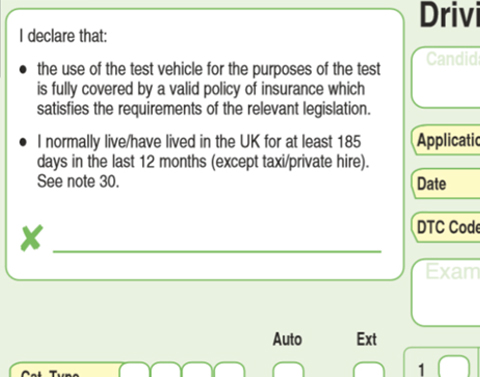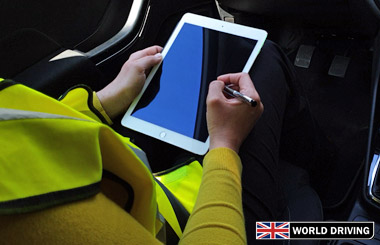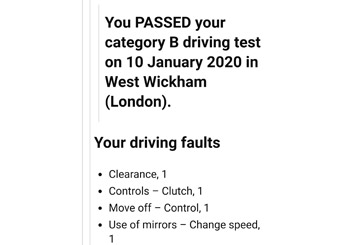What to expect on the day of your driving test
Subscribe for more tips on our YouTube channel
The driving test was something to be feared with strict, stern examiners taking candidates out on the hardest test routes. But now examiners, old and new are fully trained in friendly customer service skills, including how to deal with nervous candidates. Which makes the whole driving test a much more positive experience.
Mock driving test videos can be found here.
What's involved?
Firstly, you need to pass your theory test before you can apply for the practical test. The waiting time for a practical test can be long (especially in London). Don't rush into it, only book it when you feel ready.
Watch Adrian as he takes his mock driving test.
Some test centres operate Saturday and Sunday tests. In the summer, evening tests at an extra cost.
What is the most common reason for failing a UK driving test?
Common driving test myths can be found here.
|
|
Key points
At the time of your test, a few examiners will enter the waiting room and one of them will call your name and ask to see your provisional licence. As the examiner checks your licence they'll ask you to read and sign the insurance and residency declaration. Sign your usual signature, the same as on your licence.

The examiner will also ask you if you'd like your instructor or accompanying driver to be there for the result and end of test feedback. Again, this is your choice but it can be very useful for your instructor to listen to, especially if you've failed as they'll be able to help you improve.
Once outside
Remember to wear glasses or contact lenses if you need them. If it's a new style number plate then it'll be from a distance of 20 metres. Or an old style number plate from 20.5 metres. If you can't read it then you'll be given another chance with a different plate. If you can't read that, the examiner will measure the exact distance from another plate and if you can't read it again then unfortunately it will be a test fail. Once you've read the number plate, you'll walk to your car.
If you agree, they'll say "The test will last about 38 to 40 minutes and will include about 20 minutes of independent driving and various road and traffic conditions. I will ask you to complete one manoeuvre and we may carry out an emergency stop. The sort of things you've been practising with your instructor or accompanying driver."

![]() The examiner will ask you one 'show me' question and one 'tell me' question.
The examiner will ask you one 'show me' question and one 'tell me' question.
The 'tell me' question will be asked before you start driving. A 'tell me' question is where you would have to explain how you'd carry out a safety task.
The 'show me' question will be asked while you're driving. That's where you'd have to actually show the examiner how you'd carry out a safety task.
Here are all the 'show me, tell me' questions.
Failure to answer one or both will result in a driving fault (also known as a minor).
Losing control of the car when answering the 'show me' question will result in either a serious or dangerous fault (test fail).
Find out what to do if you find yourself in the wrong lane on the driving test.
![]() Part of the test will include a reversing exercise (reverse/bay parking, pulling up on the right-hand side of the road and reversing 2 car lengths or driving forward into a car park bay then reversing out). You'll only carry out one manoeuvre. But, you may also be asked to carry out an emergency stop. Manoeuvres information can be found here.
Part of the test will include a reversing exercise (reverse/bay parking, pulling up on the right-hand side of the road and reversing 2 car lengths or driving forward into a car park bay then reversing out). You'll only carry out one manoeuvre. But, you may also be asked to carry out an emergency stop. Manoeuvres information can be found here. ![]() Assessing you driving independently is part of the test. This will take up roughly 20 minutes of the driving test and will consist of you either following traffic signs or directions from a sat nav. Read more about Independent driving here.
Assessing you driving independently is part of the test. This will take up roughly 20 minutes of the driving test and will consist of you either following traffic signs or directions from a sat nav. Read more about Independent driving here.
![]() You are allowed no more than 15 driving faults and not allowed any serious or dangerous faults. Driving test sheet can be found here.
You are allowed no more than 15 driving faults and not allowed any serious or dangerous faults. Driving test sheet can be found here.
The examiner uses an iPad to record any faults plus other things such as if you've completed a hill start.
![]() After the test has finished, your examiner will tell you your result and explain any faults. Your driving instructor can listen into this part if you wish and help you improve on anything that you got wrong. The test result will also be emailed to you (example below).
After the test has finished, your examiner will tell you your result and explain any faults. Your driving instructor can listen into this part if you wish and help you improve on anything that you got wrong. The test result will also be emailed to you (example below).

Examples of dangerous faults
